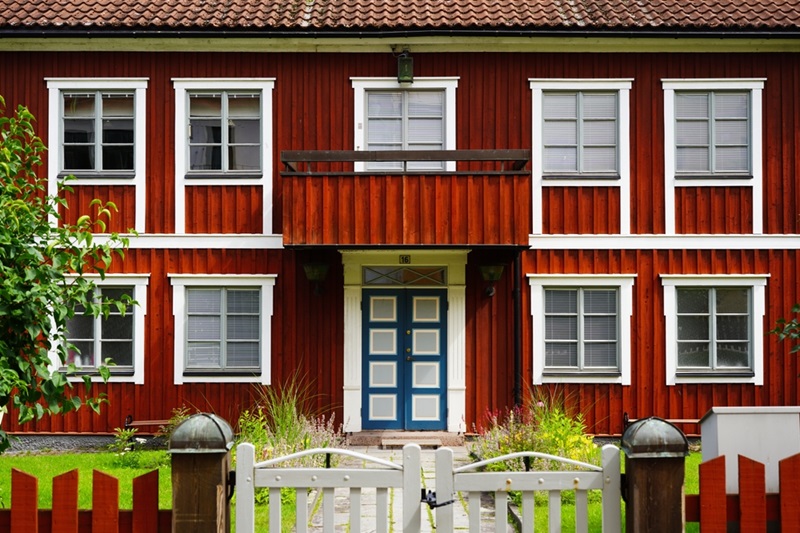In pursuit of a simpler life, Swedes have a unique approach to decluttering that goes beyond mere tidying up.
Known as the “Swedish Death Cleaning” method, or “döstädning“, this cultural practice has gained global attention for its blend of organisation and mindfulness.
This article explains what Swedish Death Cleaning is, exploring its origins, principles, and steps.
Far from a morbid practice, Swedish Death Cleaning offers a thoughtful perspective on possessions, encouraging you to reflect on the significance of your belongings and ultimately leave behind a more meaningful and manageable legacy.
What Is Swedish Death Cleaning?
Swedish Death Cleaning, or “döstädning” in Swedish, isn’t as morbid as it sounds! It’s a decluttering method popularised by the Swedish author Margareta Magnusson in her book The Gentle Art of Swedish Death Cleaning.
The idea behind Swedish Death Cleaning is to gradually declutter your living space throughout your life so that in the event of your death your friends and family won’t be burdened with the task of sorting through a lifetime of belongings.
It makes the task of clearing the house when someone dies much simpler and leaves behind sentimental possessions for your loved ones.
The process involves keeping track of your belongings, reflecting on their importance in your life, and letting go of items that no longer bring joy or hold meaningful value.
If you’re looking to declutter mindfully, it’s a cleaning approach well worth considering.
What Are the Steps Involved in Swedish Death Cleaning?
If you want to give the Swedish Death Cleaning method a go, here are the steps that are involved:
1. Start decluttering early
In Magusson’s book, she encourages anyone over 65 to start decluttering and organising their belongings in preparation for their death.
However, she stresses that it’s never too early to start—the earlier you start, the easier the process is.
Begin decluttering well before old age or health issues become significant concerns. This allows for a gradual and less overwhelming approach.
2. Categorise your possessions
Decluttering your home and valuing the significance of every possession can be overwhelming.
Therefore, your first step should be to divide your belongings into categories (clothing, books, documents, sentimental items, etc.).
This makes it easier to systematically go through your belongings and helps you feel less overwhelmed while decluttering.
We suggest sorting through your wardrobe first, then doing the rest of the decluttering by size.
Get rid of any old or broken pieces of furniture first before moving on to smaller items. Finish by organising your digital files, which take up no physical space whatsoever.
3. Reflect on the significance of each item
As you go through your items in order – clothing, large items, smaller items, digital files – reflect on the significance of each.
Consider whether each item holds sentimental value, brings you joy, or serves a practical purpose in your current life.
When using the Swedish Death Cleaning Method, you should keep only the items that truly bring you joy or have significant meaning.
If an item no longer holds value for you, consider letting it go. This might involve donating, selling, or giving away items that you no longer need or want.
Even if an item no longer serves you a purpose, remember to reflect on the legacy you want to leave behind. This is integral to the practice.
Identify items that tell your life story and are important for preserving your memories. These items may be passed down to family members or friends.
4. Organise as you go
While valuing the significance of your belongings, organise the possessions you decide to keep.
Create a storage system for your wardrobe, put keep-sakes together in a box, and try to keep different categories of belongings together in one place.
Don’t forget about the organisation of important documents either, such as wills, financial records, and other legal papers.
Your loved ones will need access to these after you die, so they should be organised and easily accessible.
Communicate the location of these documents to a trusted family member or friend.
5. Discuss with loved ones
Although not essential, telling your loved ones that you’re using the Swedish Death Cleaning method is a good idea.
Friends and family members might get upset with the idea that you’re preparing for death, so it’s important to reassure them it’s just to leave your belongings in a tidy state.
If appropriate, you might also wish to get friends or family members to help declutter your home.
This can help avoid misunderstandings and give your nearest and dearest the chance to keep any items that bring them joy.
Communication and consideration for others are what set this method apart from other decluttering processes.
6. Make it a regular thing
Swedish Death Cleaning is not a one-time process. Make sure that you regularly reassess your possessions and continue to declutter and organise as needed.
This ongoing practice can help maintain a simplified and organised living space up until the point of death.
Remember that the ultimate goal of Swedish Death Cleaning is to make the process easier for your loved ones and to create an intentional, organised, and meaningful living environment.
This is only possible by keeping on top of your possessions.
Why Is it Called Swedish Death Cleaning?
You might be confused as to why an effective decluttering method has been called “death cleaning.”
The term “Swedish Death Cleaning” actually comes from the Swedish tradition of “döstädning,” which combines the Swedish words “dö” (die) and “städning” (cleaning).
It encourages individuals to take proactive steps towards decluttering and organising when the time comes.
Rather than a gloomy name, it stands as a reminder that we need to get organised before it’s too late! Not only does it make your home a more comfortable place to live, but it also makes things easier for your loved ones.
What’s the Difference Between Swedish Death Cleaning and Decluttering?
Swedish Death Cleaning and decluttering share the common goal of simplifying your living space, but they differ in their underlying philosophies, motivations, and approaches. Here are some key distinctions between the two:
Motivation and timing
- Swedish Death Cleaning: This approach is motivated by the idea of preparing for the end of life and minimising the burden on loved ones. It encourages you to start decluttering before old age or illness becomes a significant concern.
- Decluttering: Decluttering, in a general sense, may be motivated by a desire for a more organised and aesthetically pleasing living environment. It may not necessarily have a specific end-of-life focus and can be done at any stage of your life.
Philosophy
- Swedish Death Cleaning: This method is rooted in the Swedish cultural notion of responsibility and consideration for others. It involves reflecting on the significance of possessions, keeping only what brings joy or holds meaning.
- Decluttering: Decluttering can have various motivations, including creating a more efficient and stress-free living space, improving mental well-being, or simply embracing a minimalist lifestyle. It doesn’t necessarily delve into the deeper meaning of possessions.
Sentimental value
- Swedish Death Cleaning: This organisational cleaning method places a strong emphasis on evaluating the sentimental value of possessions and intentionally preserving items that tell the story of your life.
- Decluttering: While sentimental items may be considered during decluttering, the emphasis can also be on eliminating items that no longer serve a practical purpose or bring joy, regardless of their sentimental value.

Hannah has a passion for cleaning. She worked her way around Australia by cleaning hostels in exchange for free accommodation and used her cleaning skills to bag a job as a chalet host for a luxury ski company in France.






